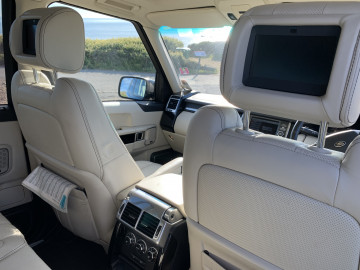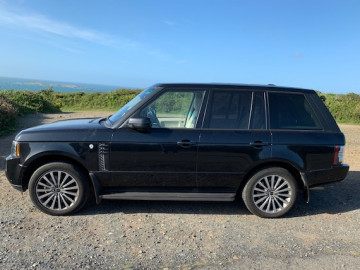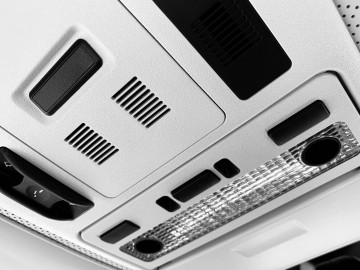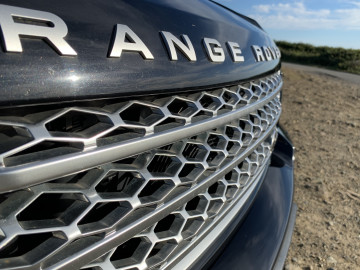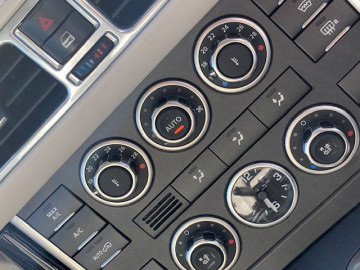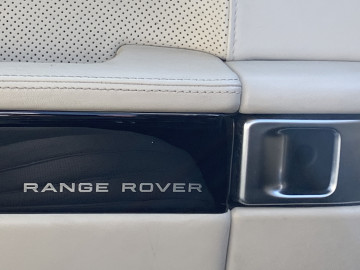
Simply the Best Range Rover Drive ... ever
Range Rover: L322 - Autobiography (2011)
Love 'em or Hate 'em, German engineers know how to build things to last and stand out from the crowd. Read on to learn how the German's helped to rescue Land Rover's floundering flagship model.
The Range Rover took a bit of a knock in 1994 with the introduction of its first reincarnation as the P38A. The P38A was simply pants ... in almost every respect. But then BMW came to the rescue of Land Rover, both financially and technically. The marriage of our German cousins' technological prowess to Land Rover's own creative design resulted in the 2002 release of the third generation Range Rover, the L322. And what a car that proved to be. Benefiting from the lessons of how NOT to do it, this car was a hit for Land Rover from the start.
Our vehicle, built in 2011, is one of the later cars by which time the Best had simply got Better. It is a top of the range Autobiography model. Loaded with the supreme 5Ltr supercharged V8 Petrol (Jaguar AJ-8) driven powertrain. And, at last, the suspension and technical wizardry had been improved sufficiently to allow this 2.6 tonne behemoth to safely unload its full 515 bhp onto the black stuff. It delivered 0-60 in a blistering 5.9 seconds and could cruise at a speed of 140mph. OK, not a Ferrari or Porsche performance, but who was looking down on who while stopped at the traffic lights?
In any event, could those fancy European sports cars wade in 2.4 feet of water, negotiate a 155 degree break-over ramp angle, cross ice fields, climb a mountainside or drive non-stop across Europe (save the regular petrol stops!) with skiing kit for a family of 5 in the back. Well our vehicle regularly did just that for its one and only owner, for no less than 10 years. And all the while the kids had the tv on in the back and the wife had access to her twin-lit vanity mirror to step out at the other end looking a million dollars! The Ferrari boys may have got the first seat at the bar ... but they were nursing a bad back and the family had to join them later, having followed them on with the cases by train!
More InfoOur lead photo was symbolically taken in front of one of the watchtowers built in Germany's infamous 'Atlantic Wall', built almost 70 years before our Range Rover and still standing proud today. German's certainly build things to last. That resilient German engineering (and their Duetchmarks) were needed to return the Range Rover mark to its former glory.
The second Range Rover variant, the P38A, was nothing short of embarrassing ... journalists struggled to find anything positive to say whatsoever. Then once committed, disappointed owners added unreliability to their troubles. It wasn't wholly the fault of the team at Range Rover. The company had been woefully deprived of development capital for decades. At the time the whole of the British Automotive industry was in dire straights,
But then when all seemed lost, BMW stepped in with capital and a shot of adrenaline to inject into the flagging engineering team. Almost immediately a re-worked Range Rover was at the top of their list of development priorities. This resulted in the 2002 release of the third generation Range Rover, the L322. Avoiding all the pitfalls of the existing model, this turned out to be a golden birth. To find some one who didn't like the L322 was as likely as Ranulph Fiennes coming home from an adventure with the same number of toes as he left with. The irony of this success story is that BMW never reaped the reward for their remarkable contribution. By the time of the L322's launch, the Land Rover company had been sold on by them to Ford!
Our L322, built in 2011, is a top of the range Autobiography model. We believe that it represents the very pinnacle of Range Rover's offering. Sure, later models had more toys and mind boggling technology. But the 'drive' of this model has never been matched. So let's start with the powertrain.
This Autobiography is loaded with the supreme 5Ltr supercharged V8 Petrol (Jaguar AJ-8) engine. That links to the 6 speed automatic / manual gearbox. And at last the suspension and technical traction wizardry had been improved sufficiently to allow this 2.6 tonne vehicle to safely unload its full 515 bhp without reservation. There is more computer processors on this car working on how to keep the optimum distribution of power on the road than you would find in Nasa's Luna Landing Module. It delivers 0-60 in a class beating 5.9 seconds and could cruise at a speed of 140mph. Not a Ferrari or Porsche performance, but if you can afford to fuel this car then you can afford a Porsche back home in garage for playtime.
What makes this Autobiography truly special is that none of this road performance was achieved at the cost of the Range Rover's off-road abilities. In fact the opposite. This car was, of its time, the most advanced off-roader that money could buy. Selection within the saloon between three suspension settings, 5 surface types, traction aids, hi/low ratio selection and a fully automated hill decent control, left the car wanting for nothing when faced with terrain that would send other cross country vehicles running for the plains. And while doing that the kids need not even look up from their Game Boy that could be fed onto the dual screens set in the front headrests.
That leads us onto the cabin, with its pollen suppressed climate control, its cooled / heated leather arm chairs and an 10 speaker bluetooth audio system. This vehicle in reality was a hyper-charged business lounge on wheels. In fact, the owner of this car preferred it to the successor Range Rover (the L405) that was released the year following his purchase of the L322. So much so that he kept this one as his main limo' for a decade before retiring it and making it available to ourselves for our collection.
The most recent Range Rovers have colour selected LED mood lighting, they project the model identity on the ground as a pool of light before you enter and they have endless gimmicks that are all about style and nothing to do with driving. I guess time will tell and (its new owners) Tata will be looking at the global marketplace, but the Range Rover was traditionally all about people who lived high on the hog in the country (or wished they did!) Its fashion credentials stemmed form its sublime engineering, not despite them. It is for that reason that this car represents the 'Very Best Range Rover x far'.
All that said we have to remain balanced in our view. There were two downsides to the 2011 Range Rover Autobiography. Firstly, its touchscreen info / navigation system was more promise than substance and fell a long way short of others. Also, and perhaps more importantly to young minds today, it was even less 'politically correct' than its principal exponent at the time, BBC Top Gear's Jeremy Clarkson. Our car's former owner reported a lifetime average 16 mpg and cites one memorable holiday trip where he only achieved 4.6mpg for the best part of an hour while towing a fully loaded twin axle caravan over the Central Massif in France. This was a car conceived before words like 'sustainability', 'green house gases' or 'carbon neutral' graced our lexicon. That does not excuse its excesses, but does perhaps explain them.
We love our Series Land Rovers to bits. But we must confess that on occasions a 'blast' while cosseted in absolute luxury is good ... for comparative purses only you must understand!
Part of:
Range Rovers
The Collection
Vehicle Owner: Land Rover Heritage Collection
Want to help take a look at our get involved pages.
Know something about this vehicle contact us.

